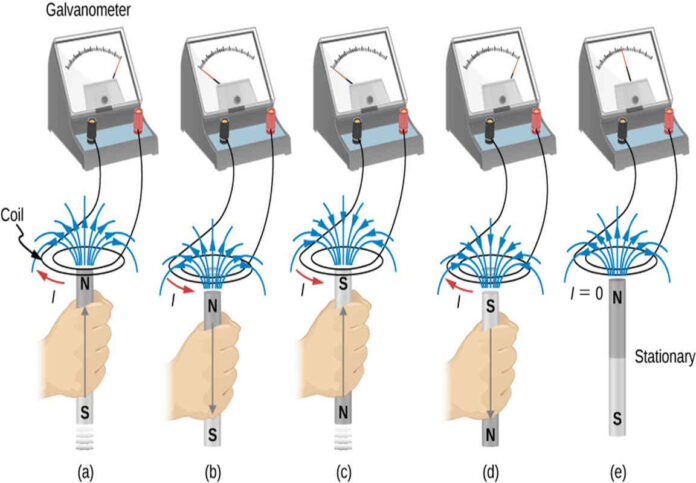
Electromagnetic Induction and and its power
Electromagnetic induction, a phenomenon that underlies many of our modern technologies, is like magic hidden in plain sight. It’s the force behind the electricity that powers our homes, charges our smartphones, and runs our industries. In this article, we’ll explore the fascinating world of electromagnetic induction and Faraday’s law, shedding light on these fundamental concepts that have shaped the way we live and work.
The Birth of Electromagnetic Induction
In the early 19th century, the scientific world was buzzing with excitement as Michael Faraday, a self-taught British physicist and chemist, embarked on a series of groundbreaking experiments. Little did he know that his work would lead to a revolution in electrical engineering.
Michael Faraday was curious about the connection between electricity and magnetism, two seemingly unrelated phenomena. He conducted numerous experiments, one of which involved moving a magnet near a closed loop of wire.
Faraday observed something remarkable: when the magnet moved, a current of electricity flowed in the wire. This phenomenon, known as electromagnetic induction, marked the birth of a new era in science and technology.
Faraday’s Law of Electromagnetic Induction
Faraday’s key insight can be summarized in his two famous laws of electromagnetic induction:
-
-
Faraday’s First Law:
A change in the magnetic field within a closed loop of wire induces an electromotive force (EMF) in the wire, causing an electric current to flow if the circuit is closed.
-
Faraday’s Second Law:
The magnitude of the induced EMF is directly proportional to the rate of change of magnetic flux through the loop.
-
Now, let’s break down these laws to understand them better.
Understanding Faraday’s First Law
Imagine you have a coil of wire, and you bring a magnet closer to it. According to Faraday’s first law, as the magnet approaches or moves away from the coil, it induces an EMF in the wire. This EMF is what we commonly refer to as voltage. If the wire forms a closed circuit (a complete loop), a current will flow.
The key point here is that electromagnetic induction requires a changing magnetic field. It’s the change in the magnetic field that generates the voltage and subsequently drives the current. Static magnetic fields, like those around a refrigerator magnet, don’t induce currents; it’s the motion or change in magnetic field strength that matters.
Illustrating Faraday’s Second Law
Faraday’s second law emphasizes the relationship between the induced EMF and the rate of change of magnetic flux. Magnetic flux (Φ) is a measure of the magnetic field passing through a given area. Mathematically, it’s defined as the product of the magnetic field strength (B) and the area (A) through which it passes, or Φ = B * A.
The second law tells us that the induced EMF (E) is directly proportional to the rate of change of magnetic flux, which can be expressed as:
E = dΦ/dt
Where:
- E is the induced EMF.
- dΦ/dt is the rate by which the magnetic flux is changing in time.
This law clarifies that the faster the magnetic flux changes within the loop of wire, the greater the induced EMF and, consequently, the stronger the current.
Real-World Applications
Understanding electromagnetic induction and Faraday’s laws is not just an exercise in scientific curiosity; it’s the foundation of countless technologies that power our daily lives.
1. Electricity Generation
The vast majority of the world’s electricity is generated using Faraday’s principles. In power plants, large generators contain coils of wire that rotate within magnetic fields. As these coils spin, they create a constantly changing magnetic field, inducing an EMF and producing electricity. This electricity is then transmitted to homes and businesses through power lines.
2. Transformers
Transformers are devices that rely on electromagnetic induction to change the voltage of electricity. They consist of two coils of wire, one with more turns (the secondary coil) and one with fewer turns (the primary coil). By varying the number of turns and the magnetic field strength, transformers can step up or step down voltage levels, making it possible to transmit electricity efficiently over long distances.
3. Inductive Charging
Wireless charging for smartphones and electric vehicles is another application of electromagnetic induction. Charging pads contain coils of wire that create a magnetic field. When you place your device on the pad, a current is induced in the device’s coil, charging its battery without the need for physical connectors.
Statistics That Illuminate the Impact
The influence of electromagnetic induction on our world is undeniable. Consider the following statistics:
- In 2021, global electricity generation reached over 27,000 terawatt-hours, with most of it coming from generators that operate on electromagnetic induction principles.
- Electric vehicles (EVs) accounted for 4.2% of all new car sales in 2020. Many EVs use inductive charging technology, highlighting the growing impact of Faraday’s discoveries on transportation.
- The number of wireless charging devices shipped worldwide is projected to reach 6.3 billion units by 2025, reflecting the increasing integration of electromagnetic induction into consumer electronics.
Making Sense of It All
While Faraday’s laws and electromagnetic induction may seem complex, their applications and impact on our daily lives are clear. From the electricity that powers our homes to the convenience of wireless charging, these principles are at the heart of modern technology.
So, the next time you charge your smartphone or turn on a light, remember that it’s not just technology at work; it’s the magic of electromagnetic induction and Faraday’s groundbreaking discoveries shaping our world.



